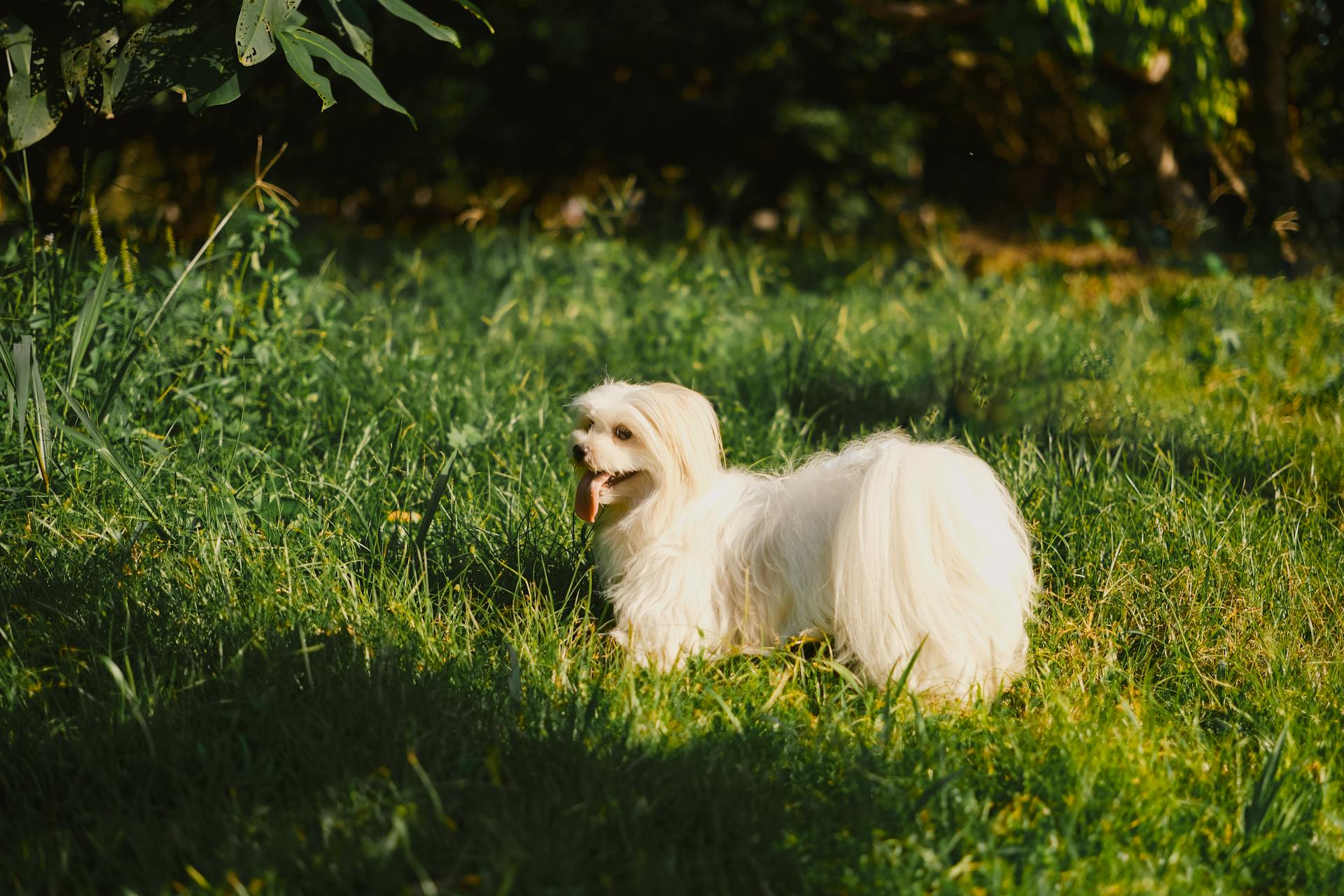
The Maltese is a toy breed that's been a favorite among dog show enthusiasts for centuries. They originated in the island of Malta over 2,000 years ago.
Their small size, silky coats, and sweet disposition make them a crowd-pleaser in the show ring. Maltese show dogs typically weigh between 4-8 pounds and stand about 8-10 inches tall.
To compete in the show ring, Maltese owners must adhere to a strict breed standard that emphasizes their distinctive white coat and gentle nature. This includes regular grooming to prevent matting and tangling of their fur.
Maltese are known for their intelligence and trainability, but they can be wary of strangers and may require time to warm up to new people and environments.
See what others are reading: 8 Week Old Boston Terrier
Physical Characteristics
The Maltese show dog is a sight to behold, and its physical characteristics are a big part of its charm. They typically weigh between 3-4 kg (7-9 lb) and stand about 20-23 cm (8-9 in) tall.
Their coat is what really sets them apart - it's dense, glossy, silky, and shiny, falling heavily along the body without curls or an undercoat. The Maltese has a pure white coat, although a pale ivory tinge or light brown spotting is permitted.
One of the most distinctive features of the Maltese is its small, floppy ears. They also have a black-button nose and dark eyes that seem to sparkle with personality.
The Maltese's tail is a beautiful tufted affair that's curved over the back, adding to its overall adorable appearance. Their short limbs are often covered in their silky coat, giving the appearance that they're floating along the floor.
Their fur is hypoallergenic, making them a great choice for people suffering from allergies. In fact, the Maltese is considered one of the best breeds for those with dog allergies.
Temperament and Personality
The Maltese is a natural-born people person, thriving on human interaction and affection. They love to be held and cuddled, making them excellent therapy dogs.
Their intelligence and social nature make them highly trainable, but they can be a bit stubborn at times. With patience and consistency, you can teach them to learn tricks and behaviors.
Maltese dogs are generally friendly with other dogs and pets, but they can be aloof towards strangers. This makes them a great choice for families with multiple pets, but you'll need to introduce them to new people and animals slowly.
One thing to keep in mind is that Maltese dogs can be prone to anxiety and loneliness if they don't receive enough attention from their owners. This is why it's essential to spend quality time with them and provide them with plenty of love and affection.
Despite their small size, Maltese dogs are bold and fearless, making them good watchdogs. However, they may bark more than needed for the task, so be prepared for some noise.
Care and Maintenance
The Maltese show dog is a stunning breed, but it requires regular care and maintenance to keep it looking its best.
Their long white coat is a hallmark of the breed, but it's also a high-maintenance feature that needs daily brushing and combing to prevent tangling and matting.
To keep their coat soft and looking good, Maltese show dogs need regular baths and conditioning, which helps prevent secondary health issues that can arise if matted hair leads to skin irritation.
Their nails grow fast, so pet owners need to trim them regularly to prevent overgrowth.
Regular ear cleaning is also essential to remove wax, debris, or excess hair that can accumulate and cause problems.
The hair around the eyes should be cleaned every day to prevent tear stains, which can be a common issue in this breed.
To keep their teeth healthy, Maltese show dogs need their teeth brushed frequently, especially as they grow older and become prone to dental disease.
Readers also liked: What Does It Mean When a Dog Shows Its Teeth
Health and Longevity
The Maltese breed is generally quite healthy, but like all breeds, they can be prone to certain health issues. These include orthopedic problems like patellar luxation and Legge-Calve-Perthes Disease, which affects the hips of Maltese puppies.
Regular checkups and care can help prevent some of these conditions, so be sure to stay on top of your Maltese's veterinary appointments. By doing so, you can help ensure your furry friend lives a long and healthy life.
With proper care, your Maltese can live up to 15 years or more, with females typically living about a year longer than males. In fact, it's not uncommon for a Maltese to reach 16 or even 17 years old.
Here are some common health issues to be aware of in Maltese dogs:
- Orthopedic issues like patellar luxation and Legge-Calve-Perthes Disease
- White dog shaker syndrome
- Patent Ductus Arteriosus (PDA)
- Portosystemic shunt (liver shunt)
- Ear infections
- Dental issues
Average Lifespan
The average lifespan of a Maltese is 13.5 years, with some living up to 15 years or more.
Females tend to live about a year longer than males.
It's not uncommon for a Maltese to reach 16 or even 17 years old with proper care.
Considering the average canine lifespan of 12 years, the Maltese breed has a relatively good life span compared to many other breeds.
With the right amount of care, your Maltese can live longer than the average lifespan.
Expand your knowledge: Shih Tzu 100 Years Ago
Common Health Problems

As a Maltese owner, it's essential to be aware of the potential health issues that can affect your furry friend. Maltese dogs are generally quite healthy, but they are prone to several hereditary conditions.
Some of the most common health issues in Maltese dogs include orthopedic problems like patellar luxation and Legge-Calve-Perthes Disease, which affects the hips of Maltese puppies.
White dog shaker syndrome is another condition that's common in small white breeds, manifesting as generalized body and head tremors.
Patent Ductus Arteriosus (PDA) is one of the most common congenital heart diseases in dogs, occurring when a blood vessel near the heart doesn’t completely close after birth.
Portosystemic shunt, also known as a liver shunt, is a blood vessel anomaly that prevents the liver from clearing the blood of toxins, leading to symptoms like poor growth, seizures, and head pressing.
Ear infections are also a common issue in Maltese dogs due to their hanging triangle-shaped ears, which can trap moisture and create a perfect environment for bacteria to grow.
Check this out: Bull Terrier Head Shape

To prevent or manage these health issues, regular check-ups with your veterinarian are crucial. In fact, keeping up with routine care can help prevent some of these conditions.
Here are some of the common health issues in Maltese dogs:
- Patellar luxation
- Legge-Calve-Perthes Disease (LCPD)
- White dog shaker syndrome
- Patent Ductus Arteriosus (PDA)
- Portosystemic shunt (liver shunt)
- Ear infections
Featured Images: pexels.com


